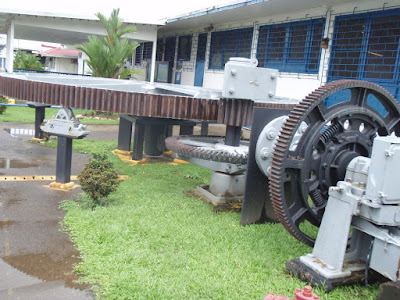The home stretch of the first leg of our travels has begun--hard to believe it, but we fly back to the US less than one month from now. Meanwhile, we are on a new continent, technically, and in a new country, Panama! There was a lot to see and do here in our first few days, which were based in the capital, Panama City, and the nearby Canal Zone.
Our first impression of the city, seen from afar at night as we came in from the airport in our $28 taxi ($8 more, I would like to note, than we then spent on a hotel room!), was that it was super-glitzy. The skyline, which you see below, is thick with skyscrapers and was all lit up, as was the waterfront we drove along. We passed American chains like Bennigans and Hard Rock. I imagine that if you stayed in one of the "better" hotels in the business district, you might never have this impression of the city challenged.

Of course, we were not staying in one of the better hotels! Our $20 a night got us a room with low lighting, a rubber-encased mattress, and a couple of not-very-family-friendly TV channels.
(The establishment managed to be classy enough not to post by-the-hour rates in the lobby, however!)
What was nice about the low-rent hotel district is that it was much closer to Casco Viejo, the old section of Panama City, than the nicer hotels are. The old town is a mix of beautifully restored colonial buildings and crumbling ones. Here is a shot of the cathedral, on the main square in that area.






On our second day in Panama, we took the train across the isthmus to Colon, the port city on the Atlantic side. The whole trip, ocean to ocean, took only an hour. 


10 kilometers from Colon are the Gatun Locks, which raise and lower ships three levels between the Atlantic Ocean and Lake Gatun. (There are two sets of locks to do the same thing on the Pacific side, Miraflores and Pedro Miguel.) We took a taxi from Colon to visit these locks and watch ships pass through, which was really cool. As a bonus, our taxi driver worked for many years in different jobs at the canal, and knew everyone on duty at the locks and explained to us how all sorts of stuff worked!
Here you can see how the wheels work to open the massive gates of the locks.
A set of gates at Gatun locks, closed. Note how much higher the water is on the left side of the gate than the right.
Here you can see the water roiling as this compartment to the right of the gate is filled. In just about five minutes, the water on both sides of the gate was at the same level...
...and the gates began to open!
Check out the two huge ships that we watched pass through the locks. Both were definitely "Panamax" ships, which means they were built specifically to be the biggest possible ships that can fit through the Panama Canal. I really don't think they had more than about a foot of leeway on either side as they came through the locks! Note the barge in front of the ship on the left that helps guide it through, and the railroad cars on either side of both ships that do the same.
Squeeeeeeze! This ship was from Russia, the other one from Hong Kong. We learned that it costs your average cruise ship about $250,000 to pass through the canal (tolls are charged by weight).


OK, so, the other cool thing we did in Colon (aside from visiting Gatun Locks) was visit the Zona Libre, which is the second-biggest tax-free shopping zone in the world. We are usually not big on shopping, but we made one very important purchase there...a new camera!! Yes, we finally replaced the one that was stolen in Bolivia. We got the same camera, but the newer model, which has some cool new features like face-recognition technology (so it now knows to tag me or Andy automatically whenever we show up in a picture).
We got the new camera just in time, too, because we really put the super-zoom to use the following day, when we went birding along Pipeline Road in Soberania National Park! The park is about halfway between Panama City and Colon and is supposed to be pretty much the best place in Central America to go birding, with over 400 species recorded there. It was a little hard to arrange a trip there, and not cheap, but we had wanted to go birding for a while and figured that this was the place to do it.
Our excellent guide was Jose from Birding Panama, who picked us up at 6 AM with his scope and superstrong binoculars in tow. He was so into the birds, it was really fun to be along with him. Definitely one of the best tour guides we've had in all our travels yet.
Here are just a few of the many beautiful birds and specimens of wildlife we saw. (And Sabrina, please forgive me if I butcher some of the names--Jose made a list for us, which I conveniently left at the hotel tonight!)
A mot mot, which is related to the quetzal. Both birds have wonderful colors and long tails.




Iguana!












Was terra scared when she saw that spiter?
ReplyDelete